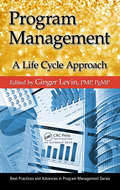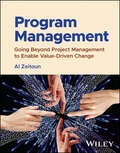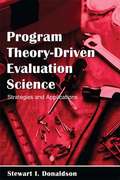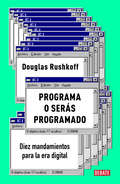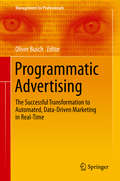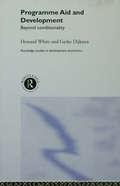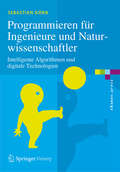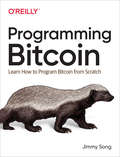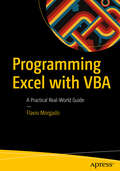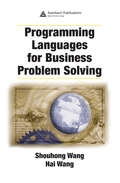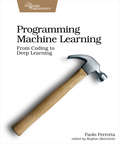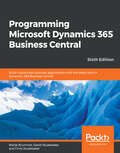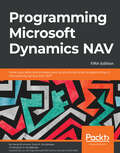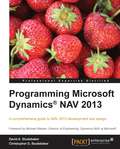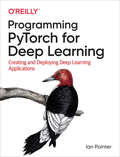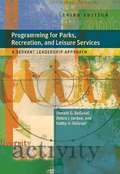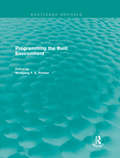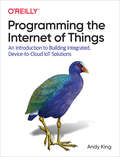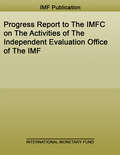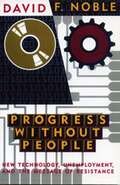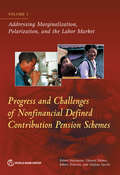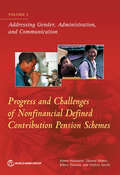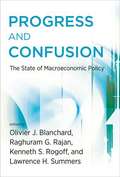- Table View
- List View
Program Management: A Life Cycle Approach (Best Practices In Portfolio, Program, And Project Management Ser.)
by Pmp Ginger Levin PgMPProgram management is a rapidly emerging offshoot of project management. So much so that AT&T, IBM, and other organizations, both large and small in all sectors, have initiated a push to certify program managers. And, although universities offer courses in program management, there are few books available to guide program managers through this
Program Management: Going Beyond Project Management to Enable Value-Driven Change
by Al ZeitounProgram Management Unique and adaptable approach to program management, offering key insights needed for professionals and business leaders to drive strategic change Program Management links business purpose, strategy, program stakeholders, benefits realization, and transformative change-making to provide a uniquely integrated view and use of program management, offering practicing initiative leaders the skills and mindset shifts needed to effectively communicate and champion programs to stakeholders. The text includes key insights into strategy execution excellence and designing risk-based governance strategies that empower a learning culture within the PMO and across the business, guidance that is customizable to the nature of strategic initiatives and change efforts at the individual and organizational level, and customization that is driven by the emphasis on the potential use of programs and projects as learning labs for different levels of complexity, organizational maturity, and diverse business contexts. Written by a highly qualified author with more than 30 years of experience in the field, Program Management covers critical topics such as: Origin of programs, program management definitions and concepts, the role of program manager vs. project manager, and the importance of value focus across the program life cycle. How leaders need to be agile, navigate political waters, manage incredible complexity, and align diverse stakeholders. Envisioning a Program Roadmap that fits context and inspires commitment to continuously achieving value. The culture for change making and the attributes for a healthy “change culture” including the future Power Skills. Also addressing the value proposition of program professionals in the future. Impact of digitalization and Artificial Intelligence (AI) on the future of programs. Creating the value-driven way of working and developing the value mindset coupled with the role of benefits management in programs and projects. The PMO as the learning engine for the enterprise and the changing role of the program offices. Becoming a Change Scientist, the maturing of value and strategic metrics in programs, and how to achieve the right metrics design and mix. For program and project managers, practitioners, PMO leaders, students in project and program management courses, and those studying for project and program management certifications, Program Management is an essential mindset, skillset, and toolset for executing a strategic plan and providing synergy, consistency in managing change, and a greater focus on achieving what matters to customers and stakeholders.
Program Theory-Driven Evaluation Science: Strategies and Applications
by Stewart I. DonaldsonProgram Theory-Driven Evaluation Science fills the gap between 21st century literature on evaluation and what is happening in practice. It features detailed examples of how evaluations actually unfold in practice to develop people, programs, and organizations. Commonly accepted strategies for practicing evaluation are outlined, followed by comprehe
Programa o serás programado: Diez mandamientos para la era digital
by Douglas RushkoffDiez mandamientos para la era digital. El debate sobre si la red es buena o mala es irrelevante: la red está aquí para quedarse y si bien somos cada vez más conscientes de los muchos problemas que ha engendrado la era digital, lo que se requiere ahora es una respuesta humana a la evolución de estas tecnologías. Para Rushkoff es imprescindible empezar a codificar los cambios por los que estamos pasando y desarrollar un nuevo patrón ético, comportamental y comercial para guiarnos. Estamos viviendo un cambio de paradigma real y sin embargo tenemos escasa comprensión de lo que nos ocurre y de cómo superarlo. La verdadera pregunta que debemos plantearnos es, ¿dirigimos la tecnología, o nos dejamos dirigir por ella y aquellos que la han dominado? En el paisaje altamente programado en el que vivimos podemos crear el software o podemos ser el software; programar o ser programados. Hasta ahora, nos hemos limito a ser programados. Eneste pequeño y valioso libro Rushkoff ofrece tanto a los entusiastas cibernéticos como a los tecnófobos las pautas para navegar en este nuevo universo digital y recuperar el control de nuestras vidas.
Programmatic Advertising
by Oliver BuschThisfundamental guide on programmatic advertising explains in detail how automated, data-driven advertisingreally works in practice and how the right adoption leads to a competitive advantage foradvertisers, agencies and media. The new way of planning, steering and measuring marketing maystill appear complex and threatening but promising at once to most decision makers. Thiscollaborative compendium combines proven experience and best practice in 22 articleswritten by 45 renowned experts from all around the globe. Among them Dr. Florian Heinemann/Project-A,Peter Würtenberger/Axel-Springer, Deirdre McGlashan/MediaCom, Dr. MarcGrether/Xaxis, Michael Lamb/MediaMath, Carolin Owen/IPG, Stefan Bardega/Zenith,Arun Kumar/Cadreon, Dr. Ralf Strauss/Marketingverband,Jonathan Becher/SAP and many more great minds.
Programme Aid and Development: Beyond Conditionality (Routledge Studies in Development Economics)
by Howard White Geske DijkstraThis important contribution to the literature on development economics analyses the effectiveness of programme aid - i.e. aid that is not given in the form of projects. Using real world examples from countries such as Nicaragua, Tanzania, and Vietnam this book deals with one of the core issues in development economics today.
Programmieren für Ingenieure und Naturwissenschaftler: Intelligente Algorithmen und digitale Technologien (eXamen.press)
by Sebastian DörnZiel des Buches ist es, Ingenieuren oder Naturwissenschaftlern die Programmierung als Schlüsselqualifikation mit zahlreichen Anwendungsmöglichkeiten vorzustellen. Der Autor erläutert algorithmische Methoden, die heute hinter digitalen Produkten und Dienstleistungen stehen. Zentrale Anwendungen sind die Künstliche Intelligenz, das Data Mining, die Predictive Analytics, die Industrie 4.0 oder das Internet der Dinge. Die digitale Datenanalyse mit den zugehörigen Algorithmen ist die zentrale Grundlage vieler neuer IT-Technologien. Hierzu werden große Datenmengen verschiedenster Anwendungsfelder verarbeitet und auf gewisse Muster analysiert, um die relevanten Informationen zu extrahieren. Diese sogenannten intelligenten Verfahren sind die Basis für nahezu alle Innovationen in unserer digitalisierten Welt. Mit Hilfe dieser Art der Informationsverarbeitung werden durch die Kombination von mathematischen Modellen und algorithmischen Verfahren neue digitale Geschäftsmodelle erschaffen.
Programming Bitcoin: Learn How to Program Bitcoin from Scratch
by Jimmy SongDive into Bitcoin technology with this hands-on guide from one of the leading teachers on Bitcoin and Bitcoin programming. Author Jimmy Song shows Python programmers and developers how to program a Bitcoin library from scratch. You’ll learn how to work with the basics, including the math, blocks, network, and transactions behind this popular cryptocurrency and its blockchain payment system.By the end of the book, you'll understand how this cryptocurrency works under the hood by coding all the components necessary for a Bitcoin library. Learn how to create transactions, get the data you need from peers, and send transactions over the network. Whether you’re exploring Bitcoin applications for your company or considering a new career path, this practical book will get you started.Parse, validate, and create bitcoin transactionsLearn Script, the smart contract language behind BitcoinDo exercises in each chapter to build a Bitcoin library from scratchUnderstand how proof-of-work secures the blockchainProgram Bitcoin using Python 3Understand how simplified payment verification and light wallets workWork with public-key cryptography and cryptographic primitives
Programming Excel with VBA: A Practical Real-World Guide
by Flavio MorgadoLearn to harness the power of Visual Basic for Applications (VBA) in Microsoft Excel to develop interesting, useful, and interactive Excel applications. This book will show you how to manipulate Excel with code, allowing you to unlock extra features, accuracy, and efficiency in working with your data. Programming Excel 2016 with VBA is a complete guide to Excel application development, using step-by-step guidance, example applications, and screenshots in Excel 2016.In this book, you will learn:How to interact with key Excel objects, such as the application object, workbook object, and range objectMethods for working with ranges in detail using codeUsage of Excel as a database repositoryHow to exchange data between Excel applicationsHow to use the Windows API to expand the capabilities of ExcelA step-by-step method for producing your own custom Excel ribbonWho This Book Is For:Developers and intermediate-to-advanced Excel users who want to dive deeper into the capabilities of Excel 2016 using code.
Programming Languages for Business Problem Solving
by Shouhong Wang Hai WangIt has become crucial for managers to be computer literate in today's business environment. It is also important that those entering the field acquire the fundamental theories of information systems, the essential practical skills in computer applications, and the desire for life-long learning in information technology.Programming Languages
Programming Machine Learning: From Coding to Deep Learning
by Paolo PerrottaYou've decided to tackle machine learning - because you're job hunting, embarking on a new project, or just think self-driving cars are cool. But where to start? It's easy to be intimidated, even as a software developer. The good news is that it doesn't have to be that hard. Master machine learning by writing code one line at a time, from simple learning programs all the way to a true deep learning system. Tackle the hard topics by breaking them down so they're easier to understand, and build your confidence by getting your hands dirty. Peel away the obscurities of machine learning, starting from scratch and going all the way to deep learning. Machine learning can be intimidating, with its reliance on math and algorithms that most programmers don't encounter in their regular work. Take a hands-on approach, writing the Python code yourself, without any libraries to obscure what's really going on. Iterate on your design, and add layers of complexity as you go. Build an image recognition application from scratch with supervised learning. Predict the future with linear regression. Dive into gradient descent, a fundamental algorithm that drives most of machine learning. Create perceptrons to classify data. Build neural networks to tackle more complex and sophisticated data sets. Train and refine those networks with backpropagation and batching. Layer the neural networks, eliminate overfitting, and add convolution to transform your neural network into a true deep learning system. Start from the beginning and code your way to machine learning mastery. What You Need: The examples in this book are written in Python, but don't worry if you don't know this language: you'll pick up all the Python you need very quickly. Apart from that, you'll only need your computer, and your code-adept brain.
Programming Microsoft Dynamics 365 Business Central: Build customized business applications with the latest tools in Dynamics 365 Business Central, 6th Edition
by David Studebaker Mark Brummel Chris StudebakerExplore the fundamentals of Dynamics 365 Business Central and the Visual Studio Code development environment with the help of useful examples and case studiesKey FeaturesTailor your applications to best suit the needs of your businessExplore the latest features of Business Central with examples curated by industry expertsIntegrate Business Central features in your applications with this comprehensive guideBook DescriptionMicrosoft Dynamics 365 Business Central is a full ERP business solution suite with a robust set of development tools to support customization and enhancement. These tools can be used to tailor Business Central's in-built applications to support complete management functions for finance, supply chain, manufacturing, and operations.Using a case study approach, this book will introduce you to Dynamics 365 Business Central and Visual Studio Code development tools to help you become a productive Business Central developer. You'll also learn how to evaluate a product's development capabilities and manage Business Central-based development and implementation. You'll explore application structure, the construction of and uses for each object type, and how it all fits together to build apps that meet special business requirements.By the end of this book, you'll understand how to design and develop high-quality software using the Visual Studio Code development environment, the AL language paired with the improved editor, patterns, and features.What you will learnProgramming using the AL language in the Visual Studio Code development environmentExplore functional design and development using ALHow to build interactive pages and learn how to extract data for usersHow to use best practices to design and develop modifications for new functionality integrated with the standard Business Central softwareBecome familiar with deploying the broad range of components available in a Business Central systemCreate robust, viable systems to address specific business requirementsWho this book is forIf you want to learn about Dynamics 365 Business Central's powerful and extensive built-in development capabilities, this is the book for you. ERP consultants and managers of Business Central development will also find this book helpful. Although you aren't expected to have worked with Dynamics Business Central, basic understanding of programming and familiarity with business application software will help you understand the concepts covered in this book.
Programming Microsoft Dynamics NAV - Fifth Edition: Hone your skills and increase your productivity when programming in Microsoft Dynamics NAV 2017, 5th Edition
by Mark Brummel Christopher D. Studebaker David A. StudebakerCustomize your NAV applications About This Book • Gain from the insights and methods of industry-leading experts and tailor your applications to best suit the needs of your business • Learn through the detailed explanations and useful examples that are presented in a logical, step-by-step manner • This comprehensive guide is written with the goals of being used as a classroom text, a self-study text, and as a handy in-depth reference guide Who This Book Is For This book will appeal to all those who want to learn about NAV's powerful and extensive built-in development capabilities. It assumes that you understand programming and are familiar with business application software, although you aren't expected to have worked with NAV before. ERP consultants and managers of NAV development will also find the book helpful. What You Will Learn • Productively and effectively use the development tools that are built into Dynamics NAV • Understand the strengths of NAV's development tools and how they can be applied to address functional business requirements • Introduction to programming using the C/AL language in the C/SIDE Development Environment • Explore functional design and development using C/AL • Leverage advanced NAV development features and tools • Get to know the best practices to design and develop modifications of new functionality integrated with the standard NAV software In Detail Microsoft Dynamics NAV is a full business solution suite, and a complete ERP solution, which contains a robust set of development tools to support customization and enhancement. These tools help in greater control over financials and can simplify supply chain, manufacturing, and operations. This book will take you from an introduction to Dynamics NAV and its integrated development tools to being a productive developer in the Dynamics NAV Development Environment. You will find this book very useful if you want to evaluate the product's development capabilities or need to manage Dynamics NAV based projects. It will teach you about the NAV application structure, the C/SIDE development environment, the C/AL language paired with the improved editor, the construction and uses of each object type, and how it all fits together to build universal applications. With this new edition, you will be able to understand how to design and develop using Patterns and new features such as Extensions and Events. Style and approach This book is filled with examples and will serve as a comprehensive reference guide, complementing NAV's Help files.
Programming Microsoft Dynamics NAV 2013
by Christopher D. Studebaker David A. StudebakerWritten as a practical guide, this book will show you how to utilize Dynamics NAV 2013 to its full potential. Designed to be a comprehensive reference, it should be the perfect companion for any NAV developer, manager or consultant. This book is for experienced programmers who are either new to Microsoft Dynamics NAV or for experienced developers that want to utilize the fantastic new features of NAV 2013. Managers and consultants will also benefit from understanding NAV environments in order to build on their skills and experience during development projects.
Programming PyTorch for Deep Learning: Creating and Deploying Deep Learning Applications
by Ian PointerTake the next steps toward mastering deep learning, the machine learning method that’s transforming the world around us by the second. In this practical book, you’ll get up to speed on key ideas using Facebook’s open source PyTorch framework and gain the latest skills you need to create your very own neural networks.Ian Pointer shows you how to set up PyTorch on a cloud-based environment, then walks you through the creation of neural architectures that facilitate operations on images, sound, text,and more through deep dives into each element. He also covers the critical concepts of applying transfer learning to images, debugging models, and PyTorch in production.Learn how to deploy deep learning models to productionExplore PyTorch use cases from several leading companiesLearn how to apply transfer learning to imagesApply cutting-edge NLP techniques using a model trained on WikipediaUse PyTorch’s torchaudio library to classify audio data with a convolutional-based modelDebug PyTorch models using TensorBoard and flame graphsDeploy PyTorch applications in production in Docker containers and Kubernetes clusters running on Google Cloud
Programming for Parks, Recreation, and Leisure Services: A Servant Leadership Approach (3rd Edition)
by Donald G. Degraaf Debra J. Jordan Kathy H. DegraafThis book is about the art and science of the complete programming process. The authors strive to go beyond merely presenting the knowledge and skills needed to provide quality programs; they suggest the integration of values into this process. They do this from a servant leadership perspective.
Programming the Built Environment (Routledge Revivals)
by Wolfgang F. E. PreiserArchitectural programming – the analysis of any given environment to satisfy users’ needs – has become a given prerequisite to the design process. The programming process is often a complicated one: users’ present and future needs must be identified; space allowances, often predetermined, must be considered; equipment must be accommodated; all in the most cost-effective way possible. The variety of user groups is as wide as the variety of functions architecture can shelter; moreover, the different structures and needs of clients that fall within the same use classification differs so greatly that every program presents a new challenge. You cannot, for example, use the same program for every hospital you design. In Programming the Built Environment, first published in 1985, noted architect Wolfgang F. E. Preiser has compiled a wide range of architectural programs demonstrating applications of basic principles for different client groups. This book will be of interest to students of architecture and planning.
Programming the Internet of Things: An Introduction To Building Integrated, Device-to-cloud Iot Solutions
by Andy KingLearn how to program the Internet of Things with this hands-on guide. By breaking down IoT programming complexities in step-by-step, building-block fashion, author and educator Andy King shows you how to design and build your own full-stack, end-to-end IoT solution--from device to cloud. This practical book walks you through tooling, development environment setup, solution design, and implementation.You'll learn how a typical IoT ecosystem works, as well as how to tackle integration challenges that crop up when implementing your own IoT solution. Whether you're an engineering student learning the basics of the IoT, a tech-savvy executive looking to better understand the nuances of IoT technology stacks, or a programmer building your own smart house solution, this practical book will help you get started.Design an end-to-end solution that implements an IoT use caseSet up an IoT-centric development and testing environmentOrganize your software design by creating abstractions in Python and JavaUse MQTT, CoAP, and other protocols to connect IoT devices and servicesCreate a custom JSON-based data format that's consumable across a range of platforms and servicesUse cloud services to support your IoT ecosystem and provide business value for stakeholders
Programs: Civic Goods, Civil Services--What Government Can Learn From Marketing
by John A. Quelch Katherine A. JoczThe guiding principle of democracy is that the purpose of government is to serve its citizens. To a citizenry inundated with news of wrongdoing and scandals, the notion that the public comes first may seem at odds with reality. Since failure to serve citizens weakens the social bonds that make democracy viable, a democratic government stands to learn much from marketing about better communicating the positive contributions it makes to citizens' lives.
Progress Energy and Duke Energy (A)
by Guhan Subramanian Charlotte KrontirisJust as Duke Energy and Progress Energy announce their merger-forming the largest utility company in the United States, to be led by the current Progress CEO-a nuclear reactor owned by Progress suffers major damage and must be taken offline. While Progress grapples with the scope of the repairs and an increasingly skeptical insurance provider, the Duke board begins to doubt their choice for the leader of the combined companies.
Progress Report to The IMFC on The Activities of The Independent Evaluation Office of The IMF (Policy Papers)
by International Monetary Fund. Independent Evaluation OfficeA report from the International Monetary Fund.
Progress Without People: New Technology, Unemployment, and the Message of Resistance
by David F. NobleA provocative discussion of the role of technology and its accompanying rhetoric of limitless progress in the concomitant rise of joblessness and unemployment.
Progress and Challenges of Nonfinancial Defined Contribution Pension Schemes: Volume 1. Addressing Marginalization, Polarization, and the Labor Market
by Robert Holzmann Edward Palmer Robert Palacios Stefano SacchiThe individual account-based but unfunded approach to mandated public pension systems is a reform benchmark for all pension schemes, promising fair and financially sustainable benefits. Nonfinancial defined contribution (NDC) pension schemes originated in Italy and Sweden in the 1990s, were then adopted by Latvia, Norway, and Poland, envisaged but not implemented in various other countries, such as Egypt and Russia, and remain under discussion in many nations around the world, such as China and France. In its complete form, the approach also comprises budget-financed basic income provisions and mandated or voluntary funded provisions. Volume 1 of this book offers an assessment of countries that were early adopters before addressing key aspects of policy implementation and design review, including how best to combine basic income provisions with an NDC scheme, how to deal with heterogeneity in longevity, and how to adjust NDC scheme design and labor market policies to deliver on reform expectations. Volume 2 addresses a second set of issues, including the gender pension gap and what family policies can do about it within the NDC framework, labor market issues and administrative challenges of NDC schemes and how countries are coping, the role of communication in these pension schemes, the complexity of cross-border pension taxation, and much more. Progress and Challenges of Nonfinancial Defined Contribution Pension Schemes is the third in a series of books analyzing the progress, challenges, and adjustment options of this reform revolution for mandated public pension systems. 'Pension reform is a major issue in many countries. The development of the nonfinancial defined contribution pension plan in the 90's was a major advance in pension design. By reporting actual country experiences and exploring properties of plan designs, this latest collection of essays is a valuable contribution, well worth reading.' Peter Diamond Professor at Massachusetts Institute of Technology; 2010 winner of the Nobel Memorial Prize in Economic Sciences 'A highly stimulating publication for policy makers and researchers alike. It pushes the analytical frontier for policy challenges that all public pension schemes are confronted with but that the nonfinancial defined contribution approach promises to handle best.' Noriyuki Takayama President, Research Institute for Policies on Pension and Aging, Tokyo, and professor emeritus, Hitotsubashi University, Tokyo 'In a changing world where pensions are more than ever linked to labor markets, communication tools, and flexibility considerations, this anthology provides a unique up-to-date analysis of nonfinancial defined contribution pension schemes. By mixing international experiences and theoretical studies, it demonstrates the high adaptability of such pension schemes to changing social challenges.' Pierre Devolder Professor of Finance and Actuarial Sciences, Catholic University of Louvain, Belgium
Progress and Challenges of Nonfinancial Defined Contribution Pension Schemes: Volume 2. Addressing Gender, Administration, and Communication
by Robert Holzmann Edward Palmer Robert Palacios Stefano SacchiThe individual account-based but unfunded approach to mandated public pension systems is a reform benchmark for all pension schemes, promising fair and financially sustainable benefits. Nonfinancial defined contribution (NDC) pension schemes originated in Italy and Sweden in the 1990s, were then adopted by Latvia, Norway, and Poland, envisaged but not implemented in various other countries, such as Egypt and Russia, and remain under discussion in many nations around the world, such as China and France. In its complete form, the approach also comprises budget-financed basic income provisions and mandated or voluntary funded provisions. Volume 1 of this book offers an assessment of countries that were early adopters before addressing key aspects of policy implementation and design review, including how best to combine basic income provisions with an NDC scheme, how to deal with heterogeneity in longevity, and how to adjust NDC scheme design and labor market policies to deliver on reform expectations. Volume 2 addresses a second set of issues, including the gender pension gap and what family policies can do about it within the NDC framework, labor market issues and administrative challenges of NDC schemes and how countries are coping, the role of communication in these pension schemes, the complexity of cross-border pension taxation, and much more. Progress and Challenges of Nonfinancial Defined Contribution Pension Schemes is the third in a series of books analyzing the progress, challenges, and adjustment options of this reform revolution for mandated public pension systems. 'Pension reform is a major issue in many countries. The development of the nonfinancial defined contribution pension plan in the 90's was a major advance in pension design. By reporting actual country experiences and exploring properties of plan designs, this latest collection of essays is a valuable contribution, well worth reading.' Peter Diamond Professor at Massachusetts Institute of Technology; 2010 winner of the Nobel Memorial Prize in Economic Sciences 'A highly stimulating publication for policy makers and researchers alike. It pushes the analytical frontier for policy challenges that all public pension schemes are confronted with but that the nonfinancial defined contribution approach promises to handle best.' Noriyuki Takayama President, Research Institute for Policies on Pension and Aging, Tokyo, and professor emeritus, Hitotsubashi University, Tokyo 'In a changing world where pensions are more than ever linked to labor markets, communication tools, and flexibility considerations, this anthology provides a unique up-to-date analysis of nonfinancial defined contribution pension schemes. By mixing international experiences and theoretical studies, it demonstrates the high adaptability of such pension schemes to changing social challenges.' Pierre Devolder Professor of Finance and Actuarial Sciences, Catholic University of Louvain, Belgium
Progress and Confusion: The State of Macroeconomic Policy
by Raghuram Rajan Kenneth Rogoff Olivier Blanchard Lawrence H. SummersWhat will economic policy look like once the global financial crisis is finally over? Will it resume the pre-crisis consensus, or will it be forced to contend with a post-crisis "new normal"? Have we made progress in addressing these issues, or does confusion remain? In April of 2015, the International Monetary Fund gathered leading economists, both academics and policymakers, to address the shape of future macroeconomic policy. This book is the result, with prominent figures -- including Ben Bernanke, Lawrence Summers, and Paul Volcker -- offering essays that address topics that range from the measurement of systemic risk to foreign exchange intervention. The chapters address whether we have entered a "new normal" of low growth, negative real rates, and deflationary pressures, with contributors taking opposing views; whether new financial regulation has stemmed systemic risk; the effectiveness of macro prudential tools; monetary policy, the choice of inflation targets, and the responsibilities of central banks; fiscal policy, stimulus, and debt stabilization; the volatility of capital flows; and the international monetary and financial system, including the role of international policy coordination. In light of these discussions, is there progress or confusion regarding the future of macroeconomic policy? In the final chapter, volume editor Olivier Blanchard answers: both. Many lessons have been learned; but, as the chapters of the book reveal, there is no clear agreement on several key issues. ContributorsViral V. Acharya, Anat R. Admati, Zeti Akhtar Aziz, Ben Bernanke, Olivier Blanchard, Marco Buti, Ricardo J. Caballero, Agustín Carstens, Jaime Caruana, J. Bradford DeLong, Martin Feldstein, Vitor Gaspar, John Geanakoplos, Philipp Hildebrand, Gill Marcus, Maurice Obstfeld, Luiz Awazu Pereira da Silva, Rafael Portillo, Raghuram Rajan, Kenneth Rogoff, Robert E. Rubin, Lawrence H. Summers, Hyun Song Shin, Lars E. O. Svensson, John B. Taylor, Paul Tucker, José Viñals, Paul A. Volcker
